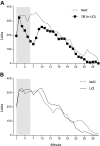Ongoing ingestive behavior is rapidly suppressed by a preabsorptive, intestinal "bitter taste" cue
- PMID: 21865540
- PMCID: PMC3213931
- DOI: 10.1152/ajpregu.00344.2011
Ongoing ingestive behavior is rapidly suppressed by a preabsorptive, intestinal "bitter taste" cue
Abstract
The discovery that cells in the gastrointestinal (GI) tract express the same molecular receptors and intracellular signaling components known to be involved in taste has generated great interest in potential functions of such post-oral "taste" receptors in the control of food intake. To determine whether taste cues in the GI tract are detected and can directly influence behavior, the present study used a microbehavioral analysis of intake, in which rats drank from lickometers that were programmed to simultaneously deliver a brief yoked infusion of a taste stimulus to the intestines. Specifically, in daily 30-min sessions, thirsty rats with indwelling intraduodenal catheters were trained to drink hypotonic (0.12 M) sodium chloride (NaCl) and simultaneously self-infuse a 0.12 M NaCl solution. Once trained, in a subsequent series of intestinal taste probe trials, rats reduced licking during a 6-min infusion period, when a bitter stimulus denatonium benzoate (DB; 10 mM) was added to the NaCl vehicle for infusion, apparently conditioning a mild taste aversion. Presentation of the DB in isomolar lithium chloride (LiCl) for intestinal infusions accelerated the development of the response across trials and strengthened the temporal resolution of the early licking suppression in response to the arrival of the DB in the intestine. In an experiment to evaluate whether CCK is involved as a paracrine signal in transducing the intestinal taste of DB, the CCK-1R antagonist devazepide partially blocked the response to intestinal DB. In contrast to their ability to detect and avoid the bitter taste in the intestine, rats did not modify their licking to saccharin intraduodenal probe infusions. The intestinal taste aversion paradigm developed here provides a sensitive and effective protocol for evaluating which tastants-and concentrations of tastants-in the lumen of the gut can control ingestion.
Figures






Similar articles
-
Post-oral sugar detection rapidly and chemospecifically modulates taste-guided behavior.Am J Physiol Regul Integr Comp Physiol. 2016 Oct 1;311(4):R742-R755. doi: 10.1152/ajpregu.00155.2016. Epub 2016 Aug 10. Am J Physiol Regul Integr Comp Physiol. 2016. PMID: 27511277 Free PMC article.
-
Rapid stimulus-bound suppression of intake in response to an intraduodenal nonnutritive sweetener after training with nutritive sugars predicting malaise.Am J Physiol Regul Integr Comp Physiol. 2012 Jun;302(11):R1351-63. doi: 10.1152/ajpregu.00702.2011. Epub 2012 Mar 14. Am J Physiol Regul Integr Comp Physiol. 2012. PMID: 22422670 Free PMC article.
-
Role of CCK1 and Y2 receptors in activation of hindbrain neurons induced by intragastric administration of bitter taste receptor ligands.Am J Physiol Regul Integr Comp Physiol. 2008 Jan;294(1):R33-8. doi: 10.1152/ajpregu.00675.2007. Epub 2007 Nov 14. Am J Physiol Regul Integr Comp Physiol. 2008. PMID: 18003792
-
Afferent signals regulating food intake.Proc Nutr Soc. 2000 Aug;59(3):373-84. doi: 10.1017/s0029665100000422. Proc Nutr Soc. 2000. PMID: 10997653 Review.
-
Interactions between Bitter Taste, Diet and Dysbiosis: Consequences for Appetite and Obesity.Nutrients. 2018 Sep 20;10(10):1336. doi: 10.3390/nu10101336. Nutrients. 2018. PMID: 30241292 Free PMC article. Review.
Cited by
-
Post-oral sugar detection rapidly and chemospecifically modulates taste-guided behavior.Am J Physiol Regul Integr Comp Physiol. 2016 Oct 1;311(4):R742-R755. doi: 10.1152/ajpregu.00155.2016. Epub 2016 Aug 10. Am J Physiol Regul Integr Comp Physiol. 2016. PMID: 27511277 Free PMC article.
-
Mouse intragastric infusion (iG) model.Nat Protoc. 2012 Mar 29;7(4):771-81. doi: 10.1038/nprot.2012.014. Nat Protoc. 2012. PMID: 22461066 Free PMC article.
-
Rapid stimulus-bound suppression of intake in response to an intraduodenal nonnutritive sweetener after training with nutritive sugars predicting malaise.Am J Physiol Regul Integr Comp Physiol. 2012 Jun;302(11):R1351-63. doi: 10.1152/ajpregu.00702.2011. Epub 2012 Mar 14. Am J Physiol Regul Integr Comp Physiol. 2012. PMID: 22422670 Free PMC article.
-
Neurons with diverse phenotypes project from the caudal to the rostral nucleus of the solitary tract.J Comp Neurol. 2018 Oct 1;526(14):2319-2338. doi: 10.1002/cne.24501. Epub 2018 Oct 16. J Comp Neurol. 2018. PMID: 30325514 Free PMC article.
-
A view of obesity as a learning and memory disorder.J Exp Psychol Anim Learn Cogn. 2014 Jul;40(3):261-79. doi: 10.1037/xan0000029. J Exp Psychol Anim Learn Cogn. 2014. PMID: 25453037 Free PMC article. Review.
References
-
- Anini Y, Fu-Cheng X, Cuber JC, Kervran A, Chariot J, Roz C. Comparison of the postprandial release of peptide YY and proglucagon-derived peptides in the rat. Pflügers Arch 438: 299–306, 1999 - PubMed
-
- Bezençon C, le Coutre J, Damak S. Taste-signaling proteins are coexpressed in solitary intestinal epithelial cells. Chem Senses 32: 41–49, 2007 - PubMed
-
- Bezençon C, Fürholz A, Raymond F, Mansourian R, Métairon S, Le Coutre J, Damak S. Murine intestinal cells expressing Trpm5 are mostly brush cells and express markers of neuronal and inflammatory cells. J Comp Neurol 509: 514–525, 2008 - PubMed
Publication types
MeSH terms
Substances
Grants and funding
LinkOut - more resources
Full Text Sources
Other Literature Sources
Miscellaneous

